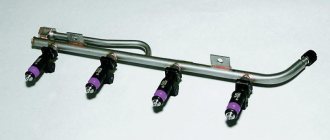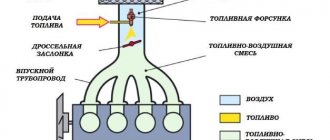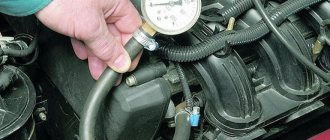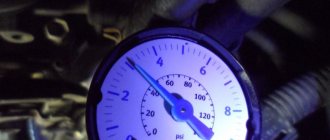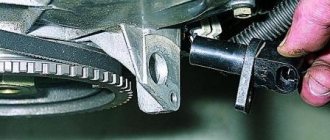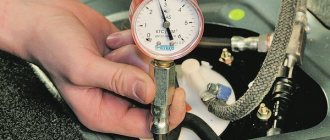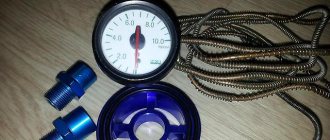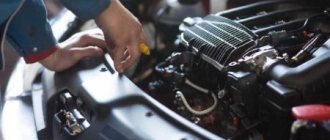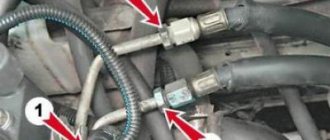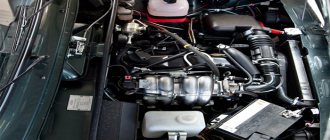Fuel pressure diagnostics
© Alexey Pakhomov, aka Is_ 18, Izhevsk
Fuel pressure is one of the most important engine parameters from a diagnostic point of view. The composition of the mixture, and therefore the behavior of the car in various modes, depends on it. Let's try to integrate diagnostic methods based on fuel pressure into a system. Naturally, you will need a fuel pressure gauge to work. It is best to purchase a device with a large, easy-to-read scale, the measurement limit is 5 - 6 kgf/cm 2. For example, like the one in the photo. The use of pressure gauges with a limit of up to 10 - 12 kgf/cm 2, used in the diagnosis of foreign cars, is hardly advisable due to the relative inaccuracy in the range of 2 - 3 kgf/cm 2. So, we connect the pressure gauge and diagnostic scanner.
1 . First of all, we evaluate the operation of the pressure regulator. To do this, turn on the pump with the engine not running. The pressure gauge should show 3. 0 +/- 0 . 2 kgf/cm2. If the pressure is below 2. 8 kgf/cm 2, it is better to change the RTD, because in power modes the machine will be dull. We pronounce the final verdict on RDT only after the next point.
2. Next, check the zero supply pressure. The name of the parameter speaks for itself - this is the pressure developed by the pump, as they say, “to the plug”, that is, fuel is not supplied. Indirectly, this parameter indicates the residual life of the pump; as it wears out, it gradually decreases.
So, take the pliers and pinch the “return”. This needs to be done quite sharply. The pressure gauge needle should literally shoot towards the limit value. If it rises slowly, then the fuel filter or fuel inlet mesh may be clogged. The limit value itself speaks volumes. If the pump is new, it will reach 5 - 6 kgf/cm2, and on pumps made in the Czech Republic - up to 7 kgf/cm2. In any case, if the pressure exceeds 5 kgf/cm2, then the pump has a sufficient resource. The manuals give different values of zero supply pressure at which the pump supposedly requires replacement. But in practice, if the pump “on the plug” presses at least 4 kgf/cm 2, it can still go on and on. In reality, customers complain about the dullness of the car when this parameter no longer reaches three “points”.
3. Turn off the pump. The pressure should drop to approximately 0. 7 kgf/cm 2 and remain at this level. If it immediately drops to zero, then either the pump check valve or the RTD is faulty. This defect, of course, is not fatal, and is often eliminated by briefly squeezing the return line. If it turns out that the RTD is at fault, it can be replaced, but changing the fuel pump due to the check valve does not seem advisable, at least according to customers.
4 . We start the engine. We carefully monitor the pressure gauge needle. This is where the larger scale comes in handy. The needle may tremble slightly, this is a consequence of large pulsations of absolute pressure (pressure in the intake receiver). These pulsations are a topic for another discussion; let’s forget about them for now. But if the needle does not tremble, but “walks”, and within a fairly wide range (up to 0.3 kgf/cm2), then the gas inlet mesh is probably clogged. For example, like in the photo. (note from Sim - this is not the most extreme option - see more “cool” cases HERE)
5 . With the engine running, the pressure will be about 2. 3 kgf/cm2. If you remove the vacuum hose from the RTD, it will rise sharply to 3 kgf/cm2 (or to the value obtained in step 1). Put the hose back on. Smoothly raise the speed to about 3000. If the pressure gradually drops, then this is another sign of a “dead” pump.
6. You can also check the performance by unscrewing the fuel supply line and applying power to the fuel pump. About 1 should run up in a minute. 5 liters. To be honest, in all my practice I have never done this; I somehow made do with the pressure gauge readings.
7. The most extreme option is a pressure of about 1 “point” and an uneven sound of the pump. The reason is there is no gasoline in the tank. Not funny. I regularly send my cars to refuel once a month.
That's all simple science. If you had to disassemble the gas tank, it makes sense to look into it with a flashlight. At the bottom you will find water, rags of dirt, sand and other unnecessary substances. They need to be removed with a pear. Or better yet, if you have one, use a vacuum unit for changing the oil. Since we remembered the tank, one more piece of advice. To prevent the gas tank from turning into a cake in winter, drill its cap from the back side. The method is stupid and not recognized by all experts, but it is radically effective. Good luck!
Signs of a fuel system malfunction
Low or excessive pressure in the fuel rail leads to the following consequences:
- unstable engine operation;
- not smooth idle;
- engine tripping;
- increased consumption;
- power drop;
- the engine stalls at idle;
- increased CO content in exhaust gases.
If you encounter one of these problems, and ECU diagnostics do not give any results, then the first thing you need to do is measure the pressure in the fuel system.
The pressure in the fuel rail is measured according to the same principle as in the tires.
What to do if P0087 occurs
It is impossible to name a “recipe” that will allow us to determine which specific malfunction led to the occurrence of the error in question. Here are the most common problems that cause low pressure in the fuel line:
Problems with the fuel pump in the tank. Most often it is this that leads to error P0087. If there are difficulties with the passage of fuel along the line, this will lead to difficulties in the operation of the fuel system. Also, this malfunction may be associated with poor contact (for example, carbon deposits or corrosion have formed on it) in the fuel station connector;
Before starting the checks described above, it is recommended to simply check the fuel filter, especially if you are not familiar with the “history” of the car. A clogged fuel filter can also cause P0087.
Note that there may be more serious problems that will lead to error P0087 than those discussed above. For example, the control unit or the high-pressure fuel pump may not work properly (not only due to the pusher). However, the driver can fix most of the malfunctions discussed above on his own, and if more serious problems arise that lead to error P0087, it will not be possible to do without the intervention of specialists. Often, more serious problems are indicated by the presence of diagnostic errors other than P0087.
( 431 votes, average: 4.59 out of 5)
Source
We take a measurement in the fuel rail.
To work we need a “pressure gauge”. But not every pressure gauge is suitable, it all depends on the pressure limit that it can measure. In our case, we need a pressure gauge with a measurement limit of up to 7 atmospheres. If you have a pressure gauge measuring up to 17 atmospheres, then such a device will show incorrect data, because it has too much error at low pressure.
In addition to the pressure gauge itself, we will need “plumbing flax”. We wind flax under the pressure gauge nozzle and put a hose with an internal diameter of 9 mm on it. Next, we tighten the whole thing with a clamp. Our device is ready for use.
In a store, such a device with a hose and drain will cost you about 1200 rubles. Measuring the fuel system at a service center will cost you about 200-300 rubles.
- Open the hood, turn off the ignition, find the fuel injector rail.
- We unscrew the plug of the fitting for fuel pressure, then use a spool to unscrew the nipple that appears, carefully placing a container or rag, because gasoline will spray due to remaining fuel pressure.
- Place the pressure gauge hose over the fitting and secure it with a clamp.
You need to check the pressure in 4 operating modes:
- measure the pressure when the ignition is turned on;
- measure the pressure at idle;
- measure the pressure with the tube removed from the fuel pressure regulator;
- measure the pressure with the return pipe pinched.
How to measure
All you need is a pressure gauge, which is designed to measure tires. It just needs to be modified a little by changing the scale. It is better to measure the pressure in the injection system with a device scale showing a variation within 6-7 atm.
There are other, more advanced measuring instruments. A special tool kit with a pressure gauge, adapter and drain hose is sold at an auto parts store. Costs about 1.5 thousand rubles.
Pressure can be measured at any car service center. They will charge nothing for the service - 500-600 rubles.
Professional pressure gauge for measuring fuel
But whatever one may say, an experienced motorist should have his own pressure gauge among his tools. If it is purchased, then with it the driver receives all kinds of adapters that allow pressure measurements on a wide variety of car brands. In addition, commercial pressure gauges are equipped with a better scale that allows you to measure pressure more accurately. And a professional pressure gauge is generally a godsend, since it makes it possible, among other things, to relieve residual pressure in the system, which increases the accuracy of the readings.
If you decide, nevertheless, to use a homemade pressure gauge, then remember!
- It is better to use a regular air pressure gauge from VAZ, since it can also measure oil pressure (you just need to unscrew the fitting).
- Instead of an adapter, you can use a regular threaded fitting.
- It is important to use high-quality clamps so that there are no gaps.
How to take measurements.
- Most often they are carried out with the ignition on. It is necessary to check whether the arrow has jumped in comparison with the standard value.
- Measurements are also carried out in XX mode.
- Measurements are carried out with the “return” compressed and with the RTD reset.
What pressure should the fuel system have?
A normal fuel system should have the following indicators:
- at idle 2.5 atm;
- ignition – not lower than 3 atm;
- when removing the vacuum tube 3.3 atm;
- when squeezing the drain tube - 7 atm;
- when accelerating, it jumps to 3, then drops to 2.5 atm.
Important! Make sure that the fuel line does not contain any holes: fuel is not leaking anywhere, otherwise the pressure measurements will be false.
- After we have pumped fuel into the system, turn off the ignition and look at the behavior of the pressure gauge. The pressure in the rail should drop to 0.7 bar and remain at this level, but if the pressure immediately drops to 0, then the problem is in the fuel pressure regulator (how to remove and replace the RTD), or the check valve of the fuel pump motor.
- We raise the engine speed to 3000 and look at the pressure gauge readings; if in this mode, the pressure gauge needle drops, the problem is a dying fuel pump.
- If the fuel pump takes a long time to build up pressure, the fuel filter or strainer in the tank may be clogged.
If, after replacing the fuel cells, your problem remains, then check other systems: IAC, TPS, MAF, compression in the cylinders.
Signs and symptoms of low pressure in the system
Weak pressure is expressed primarily by the presence of dips. You try to accelerate, press the gas pedal, nothing happens. Stopping the engine and then starting it helps (this way the pump pumps fuel). However, after ten or fifteen kilometers the situation repeats itself.
Some drivers even change the fuel filter or pump strainer in the hope of improving the situation, but this does not help. Replacing the mesh in this case is considered as a more correct option. The fact is that the pressure can drop due to a poorly functioning pump.
If the problem is not in the mesh, then the pump itself is dying. There is another reason - it is the vacuum of the fuel tank. This is how it is checked. You need to stop the car if it starts leaking, sneezing, etc. But don't turn off the engine. Then open the tank flap and loosely close it again. Continue driving, if the dips disappear, it means there is definitely a vacuum in the tank.
The lid may not be closed at all to allow air access. When there is a vacuum it is not enough. If the problem repeats, the failures do not disappear, the fuel pump must be considered the culprit.
A clogged fuel line and a malfunction of the sensor that regulates the fuel pressure immediately before injection can also cause low pressure. To reliably verify why exactly the pressure is jumping, it is necessary to carry out competent measurements. First measure the pressure of the pump, then the lines (before and after the filter), and then directly in the ramp. Such instrumental monitoring will allow us to identify a specific cause.
This sensor is often ignored by motorists, but it is its malfunction that can lead to insufficient pressure. Symptoms of a failed sensor:
- loss of car dynamics;
- Unstable engine speed in idle mode;
- difficulty starting;
- failures;
- increased fuel consumption;
- reduction in power.
Violations with RTD occur quite often, since the design of the sensor is mechanical.
- The membrane springs weaken. As a result, the valve cannot cope with the air pressure coming from the manifold, which leads to a decrease in pressure and the amount of incoming fuel.
- The valve jams, the connections lose their tightness. Because of this, the RTD becomes clogged. In general, a stuck valve can lead to an uncontrolled flow of fuel into the manifold. Fuel consumption instantly increases, the engine stops starting normally due to interruptions.
You can verify that the RTD is faulty by determining the pressure value.
| Mode | Indicators |
| Ignition on | 2.9-3 kg/cm2 |
| Engine is running | not less than 2.5 kg/cm2 |
| Vacuum hose disconnected | 3.3 kg/cm2 |
| The return line is pinched | 7 kg/cm2 |
| Peregazovka | 2.5-3 kg/cm2 |
The pressure regulator is checked first, because it is due to its malfunction that the pressure drops. If it is in order, you need to test the operation of the pump. This is done by squeezing the fuel drain check valve.
Video: how to check fuel rail pressure
Forget about fines from cameras! An absolutely legal new product - Traffic Police Camera Jammer, hides your license plates from the cameras that are installed in all cities. More details at the link.
- Absolutely legal (Article 12.2);
- Hides from photo and video recording;
- Suitable for all cars;
- Works through the cigarette lighter connector;
- Does not cause interference to radios and cell phones.
Pump operating principle
The VAZ 2109 fuel pump has a fairly simple design; the injector functions only thanks to it. It is based on two elements - an electric motor and a pump with a filter element. Please note that the “diaper” (as people call the filter for its similarity) needs to be changed on time - try not to let it work for more than 20 thousand km. Otherwise, it becomes saturated with metal shavings, dirt and other rubbish, which gets into the line and clogs the injectors.
The fuel rail contains a mixture of gasoline and air (also purified, by the way). The proportion is always the same - 14 parts of air and one part of gasoline. This is the ideal mixture for combustion to occur. But you need to pay attention to the fact that the VAZ 2109 fuel pump relay, which is controlled by an electronic unit, is involved in the operation. It is used to supply power to the pump motor. The pump's performance is high, so the engine does not run constantly, but intermittently (and depending on the operating mode of the engine, the pauses between starts may be different).
For control, there is a pressure regulator installed on the ramp. To drain excess gasoline - a check valve. With its help, all excess gasoline flows back into the tank. The VAZ 2109 fuel pump (injector) is removed if it is being repaired or replaced. The following tools will be useful:
But if the pump suddenly fails, you should first check the condition of other elements. Carefully inspect the fuse and relay of the VAZ 2109 fuel pump. If they are faulty, then the entire injector will not be able to work normally. As they say, we check the least expensive breakdowns first. If the reason is really in the fuel pump itself, then you can start dismantling it:
The main thing in this matter is accuracy, as there is a risk of damaging the fuel level sensor. And one more thing: before removing the VAZ 2109 fuel pump, you need to get rid of dirt and dust. Therefore, blow the installation area with compressed air or at least clean it with a brush.
To verify the serviceability (or malfunction) of the fuel injection pump of the VAZ 2109, just remove it and connect it directly to the battery. If it works normally, without any extraneous sounds (and air pressure is felt from the outlet), then there are no problems with it. But if it does not turn on even this way, you should think about replacing it. The price of a new one will be about 2000 rubles. Is it worth repairing an electric motor? It is unlikely that this will improve the situation for a long time, but as a temporary solution it is quite normal. But you can do this procedure only if you are confident in your abilities and have an understanding of how electric motors work.
Main elements of the fuel system of an injection engine
The injector is a complex mechanism for supplying fuel to the cylinders. The entire fuel supply process is controlled by the engine's electronic control unit (ECU). The fuel supply system also uses a parallel air supply.
Fuel pump glass
The fuel pump cup is a collection of the main elements of the fuel system assembled on one site.
The fuel pump glass includes:
- Gasoline pump
- Coarse filter
- Fuel level sensor
- Fuel pressure regulator (only in 1.6 liter engine versions)
Gasoline pump
It is one of the main elements of the fuel system. Serves to supply fuel to the cylinder block under pressure. A fuel pump is a kind of electric motor. Its operation is based on the principle of centrifugal force. Under the influence of the magnetic field formed in the stator of an electric motor, its armature is given rotation. A pump volute is installed on the anchor shaft, which directly pumps pressure into the fuel system.
The gasoline pump is very capricious and picky about the purity of the fuel consumed. Most often, the fuel pump fails due to low-quality fuel or its lack in the tank. In order for the gas pump to last as long as possible, it is necessary to refuel at proven gas stations and keep at least 25% of the tank volume in the car’s tank. If you drive with the fuel light on, the fuel pump will most likely fail much faster, since if there are bumps, the gasoline in the tank will squish from side to side and the fuel pump will suck in air.
Injectors and fuel rail
The fuel rail serves as a kind of case for the injectors; it is in it that they are installed.
The injectors of an injection engine are also one of the most important elements of the fuel system. Designed to supply fuel to the engine cylinder block under pressure. The injector sprays fuel into small droplets for better and easier ignition in the cylinder.
The injector is installed directly on the car engine, namely in the cylinder head. The number of injectors depends on the number of cylinders of the car. Lada cars have 4 cylinders, therefore there will also be 4 injectors.
Injectors are also very sensitive to fuel, but are less susceptible to damage since the fuel supplied to them is filtered through 2 filters: a coarse filter and a fine filter. But more about them a little later.
Fuel pressure control
The fuel pressure regulator (FPR) is a sensor installed on the fuel rail in 1.5-liter engine versions and installed in the tank on the fuel pump cup in 1.6-liter engine versions. It serves to ensure the required fuel pressure in the system and regulates the fuel pressure by releasing excess fuel pressure into the return line.
The RTD is a very reliable element and fails extremely rarely. The cause of its breakdown may also be poor quality fuel or the aging factor.
Fuel line
A fuel line is a set of fuel pipes designed to transport fuel from the tank to the internal combustion engine. The highway in Lada is located under the bottom of the car and is protected by plastic covers.
Fuel pump pressure VAZ 2109 injector
The fuel pump for the VAZ 2108 2109 21099 is installed with an electric injector. That is, it is turned on by supplying +12V voltage from the battery to it. It is located in the gas tank of the car. The task of the fuel pump is to supply fuel under pressure into the fuel rail, from where it is sprayed directly into the working cylinder using the injection system. Checking the performance of the fuel pump VAZ 2108 2109 21099: 1) When the ignition is turned on, the pump should start working. That is, the sound of its operation should be heard in the rear seat area. Therefore, the very first thing you need to do is check the fuse and the fuel pump relay. The assignments of the relays and fuses are labeled on the back of the mounting block cover. If the fuse is intact and the relay is working properly, then you need to remove the back seat of the car and measure the voltage at the fuel pump itself. This is done using a multimeter or wires with a 12V light bulb.
The injection VAZ 2109 has an electric fuel pump
If there is voltage at the pump, then everything is fine with the electrical part; you need to look at the fuel system. If voltage is not supplied to the fuel pump, you need to check the wire from the mounting block to the fuel pump; it may be damaged. 2) On the VAZ 2108 2109 21099 injector, it is not recommended to allow the fuel level in the tank to be less than 10 liters. Not the most convenient requirement, given that the car’s gas tank capacity is 45 liters. However, there is a reason for this: if the fuel level in the gas tank is low, the gas pump may catch air, which is unacceptable.
The operation of the pump is checked by measuring the pressure in the fuel rail. There is a special hole in the rail for connecting a pressure gauge. If there is voltage to the pump, but there is no pressure in the fuel rail, you need to check the fuel filter. If it is in order, check the fuel line from the tank to the ramp; if it is also not damaged, then the fuel pump is most likely faulty.
For further diagnostics, the VAZ 2108 2109 21099 fuel pump must be removed from the car and try to install a new one. If everything works with the new fuel pump, then the old pump is faulty. If, even with the new fuel pump, there is no pressure in the fuel rail and the car does not start, then the problem will be in the fuel system.
If you do not have a pressure gauge, the operation of the gas pump can be checked by the amount of fuel pumped per unit of time. Having unscrewed the spool, we connect a hose to the ramp, which we lower into the container for measurement. On Kalina and Grant, the pump should pump 35 liters per hour, or 0.5 liters. in a minute. At ten, the pump pumps 1 liter. in a minute. If much less fuel has leaked out, all filters must be checked. Under the bottom, next to the gas tank, there is a high-pressure filter. Another filter that needs to be checked is located in the tank itself on the fuel module. What to pay attention to: To remove the fuel pump from the car, you must remove the fuel tank. The VAZ 2108 2109 21099 fuel pump and injector cannot be removed directly from the passenger compartment, you can only check the voltage supply to it.
When considering the fuel system, you should definitely mention the VAZ 2109 injector fuel pump. The injection system consists of several components, which are basic. On our website you can also find information for newer VAZ models, for example, 2110. Nines are also equipped with electric fuel pumps that supply gasoline under a certain pressure to the ramp. Moreover, the pressure must be constant, otherwise the operation of the engine will be unstable. So, what is the injection nine fuel pump and how does it work.

